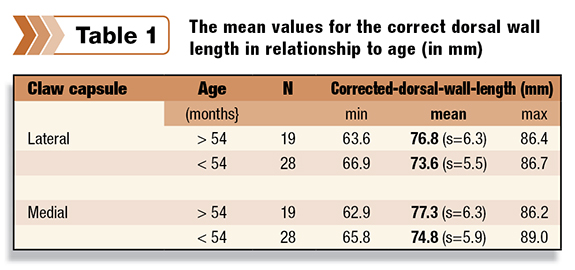Functional claw trimming was devised by Toussaint Raven in the 1970s. The protocol for claw trimming was developed based on animals and housing systems at that time. Today, the housing conditions and the appearance of animals have changed remarkably.
Not only body dimensions and body mass – but also milk yield has increased substantially. The height of withers in Holstein Friesian cows has enlarged by 12.0 cm (5 inches) over the past 30 years.
So we are interested in potential changes in the claw capsule and pedal bone dimensions associated with changes in cow dimensions.
Do we need to reassess trimming protocols?
There are also reports of thin soles or even exposure of the corium although the dorsal wall length has been measured correctly and claws have been trimmed to 75 mm. Little is known about pedal bone dimensions in the past.
There are limited data points available from anatomical postmortem studies in dairy cows. But the methods used for experimental measurement were not consistent. So it is difficult to compare these results.
Our study included 47 Holstein Friesian dairy cows with an age ranging from 18 to 152 months old. Before trimming, we measured dimensions of the claw capsule and the sole horn thickness.
The parameters of the claw capsule included the dorsal wall length, the diagonal sole length, bulb length, bulb height and the angle between dorsal wall and sole. For trimming, the sole horn thickness was measured at two points (toe and bulb).
The sole horn of the lateral claw was trimmed at the toe to a thickness of 5 mm and at the bulb to 8 mm, according to Toussaint Raven’s method. The sole horn of the medial claw was then trimmed to the level of the sole of the lateral claw (“leveling”).
This procedure allowed us to compare the size of the claw capsules in a standardized manner, i.e., by removing the variation due to any potential overgrowth of the sole.
After leveling, there was a significant (p<0,001) difference between the medial and lateral claws for the length of the dorsal wall and the sole.

After measuring the dimensions of the claw capsule of each claw, the pedal bones were isolated and measured.
The dorsal length of the pedal bone was measured at the distance from the margin of the articular surface to the tip of the bone ( Table 1 ).
Other studies measured the dorsal wall length from the extensor process to the tip. This kind of measurement includes a lot of variation in the shape of this process.
In our study, the pedal bone in older cows was significantly bigger than in cows younger than 4 to 5 years old. There were differences in size between lateral and medial pedal bones. The medial pedal bones were bigger than the lateral ones.
A low positive correlation of claw capsule and pedal bone measurements could be found. However, the claw capsule must not be greater in older cows. So we conclude that a small horn capsule does not automatically enclose a small pedal bone.
For reconsidering the correct dorsal wall length in Holstein Friesian dairy cows today, we calculated an x-value: x-value = a/sin (alpha). X is the distance to the point where the sole-corium border would intersect the dorsal wall.
This point has to be determined correctly to guarantee that the area of the cut horn at the tip represents the actual thickness of the sole.
If the dorsal wall length has not been determined correctly, the point of intersection is moved dorsally (proximal). The sole horn will be too thin when the claw will be trimmed by the Toussaint Raven method.
In his protocol, the thickness of the sole is only calculated based on the thickness of the horn visible in the first cut of the toe.
A precise determination of the dorsal wall length is the critical parameter for correct claw trimming.
After trimming the claw to a sole horn thickness of 5 mm and measuring the angle (alpha) of the claw capsule, we calculated the x-value. The overall dorsal wall length minus ‘x’ results in the corrected dorsal wall length for this claw.
In our study, 63 percent of older and 36 percent of younger cows had a corrected lateral dorsal wall length of more than 75 mm. In the medial claw we found even higher percentages: 73 percent of older cows and 50 percent of younger cows had a corrected dorsal wall length of more than 75 mm. This means that if claws are trimmed to 75 mm, some will be too short.
Additionally, we measured the area (thickness) of the first trimming cut. The sole horn thickness at the toe was already 5 mm. On average, the area had a thickness of 12.5 mm lateral and 13.5 mm medial.
In conclusion, the surface area should not be used for determining the correct sole horn thickness.
Because of the low correlation of the dorsal wall length and the pedal bone length in our study, we conclude that a reliable measurement for the shortening of toes cannot be accurately defined.
Our data support a longer dorsal wall length to be measured for shortening the toe in Holstein Friesian dairy cattle; i.e., 78 to 80 mm. Furthermore, we strongly recommend an approach considering the individual cow’s claws rather than following a strictly formalistic protocol. PD
Christoph K.W. Mülling can be contacted by email .
References omitted due to space but are available upon request. Click here to email an editor.

Sonja Bystron
Veterinary Anatomy Institute
Leipzig University





